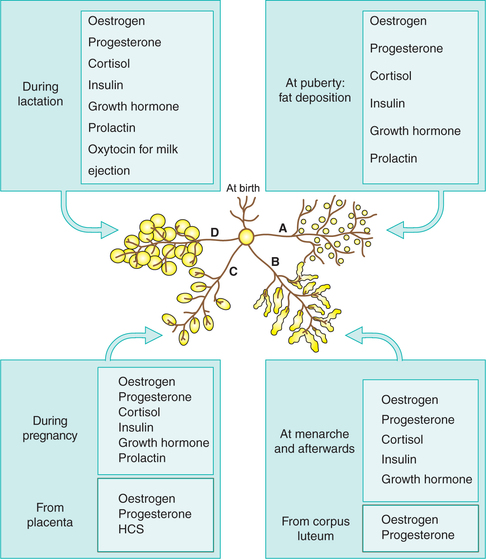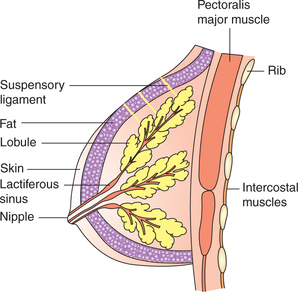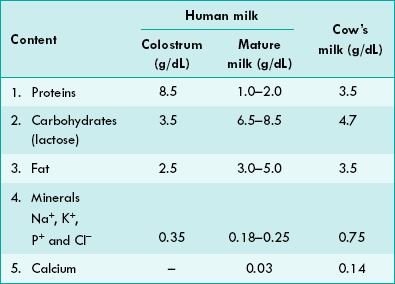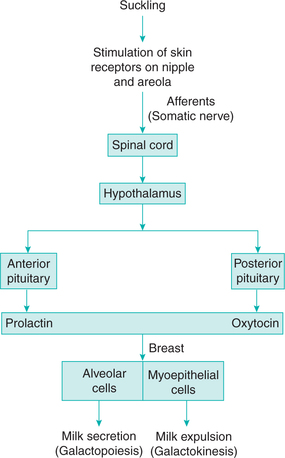Physiology of Lactation
Functional anatomy of breast
Breastfeeding is the characteristic feature of all the mammals including human beings. It has evolved as the best method of nourishing the newborn. The mammary glands (the secondary sex organs) play an important role in the lactation process.
Mammary glands are present in both the sexes; in males they remain rudimentary but in females they are well developed after puberty.
Gross anatomy. The fully developed breast is a soft, rounded, elevated structure present over the pectoral region having central dark pigmented area (areola). The central part of areola, projected above the surface, is called nipple.
Histological structure. Each mammary gland is covered by an overlying skin, and underlying it discrete masses of glandular tissue is present in the connective tissue consisting of stroma and adipose tissue (Fig. 9.5-1).
• The glandular tissue mainly consists of alveoli having secretory cells.
• The secretions from these cells are poured by apocrine manner and exocytosis into the ducts (lactiferous ducts). About 15–20 ducts open at the summit of nipple, and just before opening lactiferous ducts show a dilatation called lactiferous sinus.
• The smaller ductules are lined by a single layer of columnar epithelial cells, whereas large ducts are lined by one or two layers of cells and near the opening at the nipple these are lined by squamous cells.
• Around the alveoli, ductules and lobules are present in the myoepithelial cells. They squeeze the contents and pour their secretions into the ductules.
Control of breast development and growth
Various hormones necessary for full growth and development of mammary glands at various stages are (Fig. 9.5-2) the following.

Fig. 9.5-2 Schematic diagram of hormonal control of breast development during different stages: A, at puberty; B, at menarche and afterwards; C, during pregnancy and D, during lactation.
1. Oestrogen. It is primarily responsible for the ductal growth and fat deposition. It also causes thickening of nipples.
2. Progesterone. The development of glandular tissue mainly depends on progesterone. Both oestrogen and progesterone work best with co-operation of hypothalamo– pituitary–adrenal cortex axis.
3. Other hormones including growth hormone, thyroxine, cortisol and insulin enhance overall growth and development of mammary glands at all stages.
4. Corpus luteal and placental hormones, particularly oestrogen, progesterone and human chorionic somatomammotropic hormone (HCS or HPL) are essential for further growth of breast during pregnancy.
5. Prolactin. It is another very important hormone for the development of breasts during pregnancy and lactation. It acts on mammary gland tissue which has already grown under the influence of oestrogen and progesterone.
Physiology of lactation
Phases of lactation
The physiology of lactation can be divided into four phases:
• Preparation of breast for milk secretion (mammogenesis),
• Synthesis and secretion of milk (lactogenesis),
Mammogenesis
During pregnancy. The breast develops fully and is prepared for milk secretion after delivery (see page 455).
Lactogenesis
Stages of lactogenesis
The process of milk secretion occurs in two stages:
Stage I. In later few weeks of pregnancy, a small amount of fluid is secreted in the alveolar cells. It is called colostrum. It occurs due to high plasma levels of prolactin and placental HCS. But due to suppressive lactogenic action of oestrogen and progesterone, free flow of milk never occurs during pregnancy.
Stage II. It is the initiation of lactation after child birth. Immediately after the baby is born, sudden loss of oestrogen and progesterone secretion by the placenta allows the lactogenic effect of prolactin.
Human milk
Types of human milk. The nature and composition varies with postpartum period. Therefore, the human milk is of three types:
1. Colostrum is deep-yellow coloured fluid secreted by the mammary glands during first few days of postpartum period.
2. Transition milk or intermediate milk. It is secreted from 6th to 15th day of postpartum period. The nature and composition of the secretion changes from colostrum to mature milk. Hence it is called transition milk.
3. Mature milk is formed from 15th day of postpartum onwards and continues during the whole lactation period (7–9 months).
Composition of human milk. Human milk contains 88.5% water and about 11.5% solids. The solids include both organic and inorganic constituents. The composition of mature human milk, colostrum and cow's milk is shown in Table9.5-1.
Note. Human milk is balanced diet as it contains first class proteins (caseinogen and lactalbumin), carbohydrates, fats, mineral salts and vitamins. Therefore, it is an ideal food for the baby.
Expulsion of milk or galactokinesis
Though milk is secreted continuously into the alveoli of the breast, but it does not flow continuously from alveoli into the duct system. It depends upon the suckling reflex and some local mechanisms acting within the breast.
Suckling reflex
It is a neuroendocrinal reflex. The characteristic features and mechanism of suckling reflex (Fig. 9.5-3) are the following.
• When baby suckles, the sensory nerve endings or receptors located in skin of areola and nipple get stimulated.
• The sensory impulses are transmitted to the hypothalamus through somatic nerves (from nipple and areola to spinal cord, and then to hypothalamus). The activation of hypothalamus causes release of oxytocin and prolactin from the pituitary gland.
• The oxytocin is carried to the breasts through blood, where it causes contraction of myoepithelial cells that surround the outer wall of the alveoli. This process is called milk ejection or milk expulsion or milk let down.
• Another important observation is that suckling of one breast causes milk flow in the other breast also.
• Even stimuli such as sight, sound or crying of infant and thought of their infants also cause milk ejection, indicating the psychological component in the neuroendocrine reflex.
Maintenance of milk secretion or galactopoiesis
Maintenance of milk secretion or galactopoiesis depends upon the surge in prolactin secretion. After few weeks of child birth, prolactin level falls to its basal value; however, in nursing mothers neuroendocrine reflex causes 10–20- fold surge in prolactin secretion that lasts for 1 h. Each time when baby suckles, the impulses from nipple and areolar receptors are transmitted by somatic nerves up to the hypothalamus, which cause 1–20-fold surge in the prolactin secretion.
The amount of milk production is related to infant's demand.
 Phases of lactation
Phases of lactation

